
by Debi Blaney, NOAA Office of Ocean Exploration and Research
November 21, 2018
“The sea, once it casts its spell, holds one in its net of wonder forever.”
-Jacques Cousteau
During the Océano Profundo 2018 expedition, we explored deep-sea habitats surrounding Puerto Rico and the U.S. Virgin Islands for 22 days. This was truly a fascinating expedition, giving us glimpses into a world that is deep, dark, and cold, yet teeming with life and fascinating geological features. Almost every single day was filled with exciting observations and discoveries, as well as great experiences onboard NOAA Ship Okeanos Explorer. Below are some of our favorite moments and highlights from this expedition.

Stacey Williams and Steve Auscavitch. Image courtesy of the NOAA Office of Ocean Exploration and Research, Océano Profundo 2018: Exploring Deep-sea Habitats off Puerto Rico and the U.S. Virgin Islands. Download image (jpg, 1.5 MB).
Stacey Williams: One of my highlights of the Okeanos Explorer mission was the incredible support and partnerships from local stakeholders, especially from the local fishermen who participated in the expedition planning and dives. ¡Gracias por toda su ayuda! Also, a special thanks to the Caribbean Fisheries Management Council, especially Dr. Graciela García-Moliner. Both the fishers and the council members were crucial during this expedition. With their knowledge, we were able to characterize the habitat of commercially important fish species, and were able to record a new depth record for the queen snapper at 539 meters (1,768 feet)! The data collected during this mission will allow us to fill in some significant knowledge gaps about the population dynamics and habitats of these important deep-sea fishes.
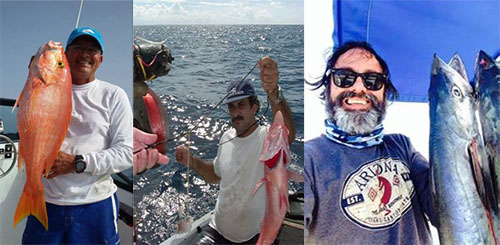
Local fisherman. Image courtesy of Stacey Williams. Download image (jpg, 200 KB).

Variety of deep-sea fish seen during the expedition. Image courtesy of the NOAA Office of Ocean Exploration and Research, Océano Profundo 2018: Exploring Deep-sea Habitats off Puerto Rico and the U.S. Virgin Islands. Download image (jpg, 1 MB).
My other highlight from the expedition was the amount of fish diversity recorded in deep-sea habitats around Puerto Rico and the U.S. Virgin Islands. We observed more than 30 species of demersal fish, including five sharks and a baby shark in an egg case. Fishes were present at every deep-sea habitat, from seamounts to ridges, and from the shallowest (250 meters; 820 feet) to the deepest of depths (4,977 meters; 16,329 feet). I’m not a fish biologist by practice, but these deep-sea fish had a lot of cool characteristics. As seen in the images above, some fish had unique body shapes, coloration, and modified fins. The toadfish Chaunax sp. (top left corner) was by far my favorite fish. Its grumpy face always brightened up my day when we saw it on a dive.
Steve Auscavitch: At the Jaguey Spur, we came across some fantastic topography that was ideal for massive deep-sea coral colonies. These vertical walls allowed us to observe colonies that were meters, not centimeters, in size. The precious coral colony pictured below is one of the largest I've ever seen in the western Atlantic. Records for these precious corals are very sparse in the Caribbean and western Atlantic. Every observation helps us better understand their diversity and distribution.
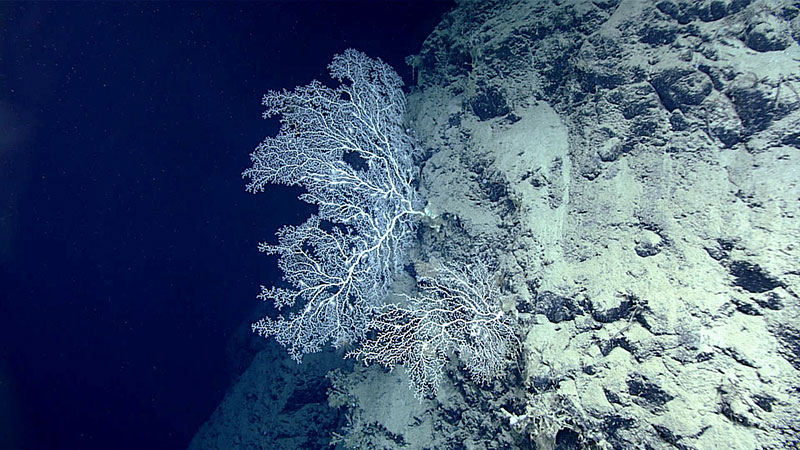
Large sea fan seen during Dive 9 of the expedition, while exploring Jaguey Spur. Image courtesy of the NOAA Office of Ocean Exploration and Research, Océano Profundo 2018: Exploring Deep-sea Habitats off Puerto Rico and the U.S. Virgin Islands. Download larger version (jpg, 1.7 MB).
Deepwater corals are known to be important habitats for fishes, but rarely do we get the chance to see it firsthand. The embryonic cat shark and egg case in the image below was found attached to an octocoral colony on one of our shallower dives. We've seen these cases before but they have all been empty, leaving us wondering what laid them. The fact that we saw this one, alive, and directly linked to a coral colony, tells us a lot about how important deep-sea corals are as nursery habitats for fishes and other organisms.
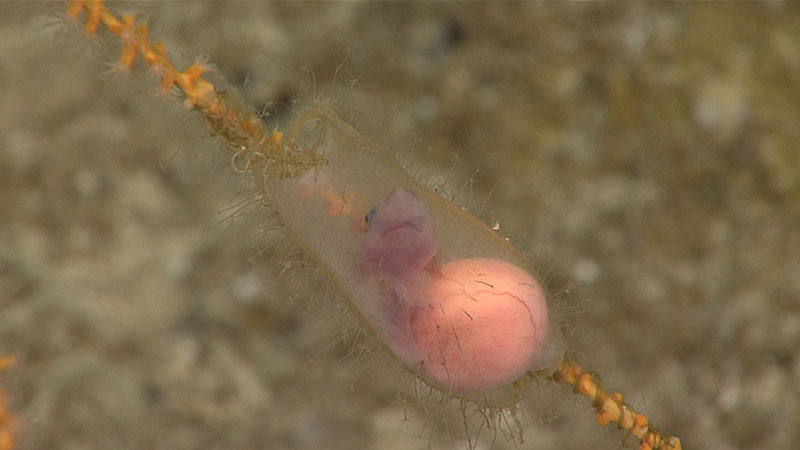
Embryonic cat shark and egg case attached to an octocoral colony. Image courtesy of the NOAA Office of Ocean Exploration and Research, Océano Profundo 2018: Exploring Deep-sea Habitats off Puerto Rico and the U.S. Virgin Islands. Download image (jpg, 741 KB).
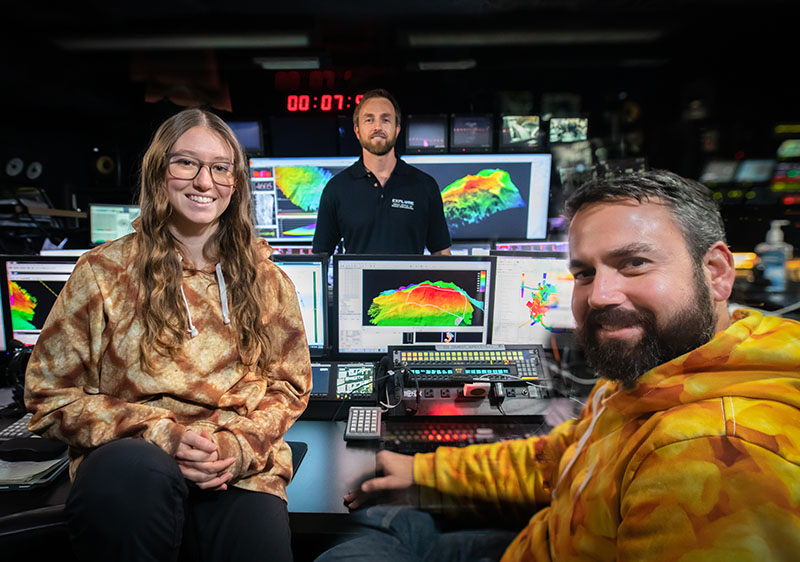
Neah Baechler, Derek Sowers, and Charles Wilkins. Image courtesy of the NOAA Office of Ocean Exploration and Research, Océano Profundo 2018: Exploring Deep-sea Habitats off Puerto Rico and the U.S. Virgin Islands. Download image (jpg, 1.8 MB).

Multibeam bathymetry of canyons in the Saba Valley region. Image courtesy of the NOAA Office of Ocean Exploration and Research, Océano Profundo 2018: Exploring Deep-sea Habitats off Puerto Rico and the U.S. Virgin Islands. Download image (jpg, 126 KB).
Derek Sowers: The image above shows multibeam bathymetry of canyons in the Saba Valley region within the U.S. Exclusive Economic Zone of the Caribbean. This large, fascinating canyon area had never been previously mapped with multibeam surveys. The canyons to the north were previously mapped by NOAA Ship Okeanos Explorer in 2015. No deep submergence exploration work has ever been completed here.
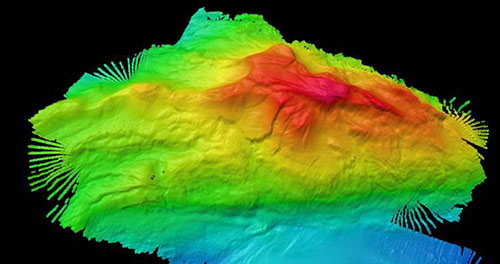
Multibeam bathymetry of Mona Seamount. Image courtesy of the NOAA Office of Ocean Exploration and Research, Océano Profundo 2018: Exploring Deep-sea Habitats off Puerto Rico and the U.S. Virgin Islands. Download image (jpg, 166 KB).
The multibeam bathymetry of Mona Seamount collected during this expedition was a definite highlight for the mapping team. Our final dive reached a depth of 5,000 meters (3.11 miles) on the north side of this massive seamount. This impressive feature rises about 7,700 meters (4.78 miles) from the Puerto Rico Trench, with the summit located at a water depth of approximately 665 meters (2,182 feet).
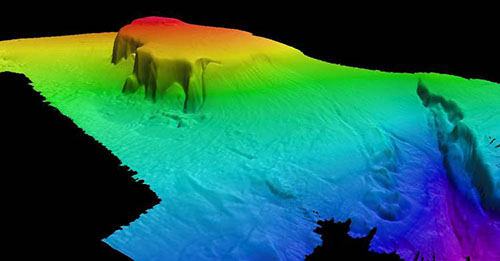
Multibeam bathymetry of Engaño Canyon and Engaño Bank. Image courtesy of the NOAA Office of Ocean Exploration and Research, Océano Profundo 2018: Exploring Deep-sea Habitats off Puerto Rico and the U.S. Virgin Islands. Download image (jpg, 135 KB).
The team was also excited to create this multibeam bathymetry map of Engaño Canyon and Engaño Bank. This area within the Dominican Republic had never been previously mapped with multibeam surveys. The data reveals a plateau area with depths as shallow as 80 meters (262 feet), distinct sand waves, and the head of a gently sloping canyon system with steep walls on the north side of the feature.
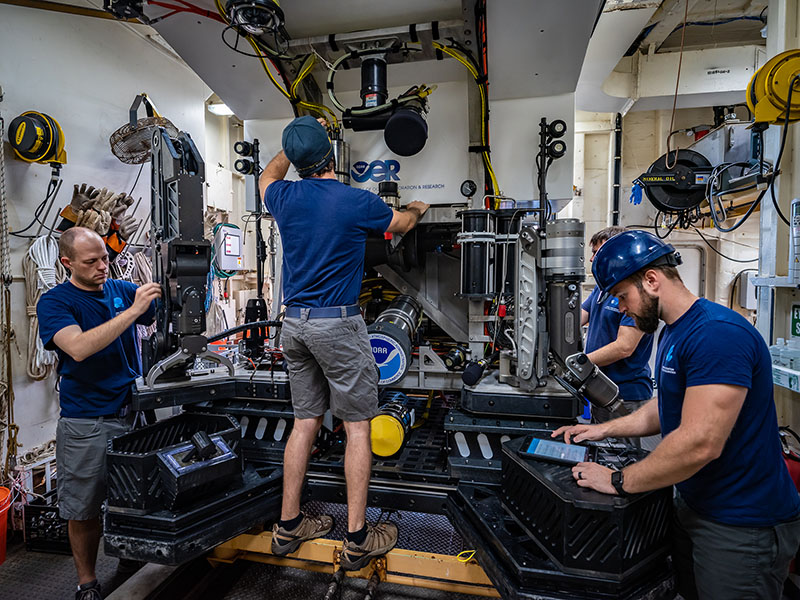
Members of the remotely operated vehicle engineering team. Image courtesy of the NOAA Office of Ocean Exploration and Research, Océano Profundo 2018: Exploring Deep-sea Habitats off Puerto Rico and the U.S. Virgin Islands. Download image (jpg, 2.4 MB).
Chris Ritter: The expedition highlight for the remotely operated vehicle (ROV) team was definitely reaching a depth of 5,000 meters (3.11 miles) at a site north of Puerto Rico. This was one of the deepest dives to reach the bottom in this region of the world and we are very proud of that. All of the hard work, diligence, and careful preparation for the vehicles to reach such great pressure at this depth really paid off with this successful dive.
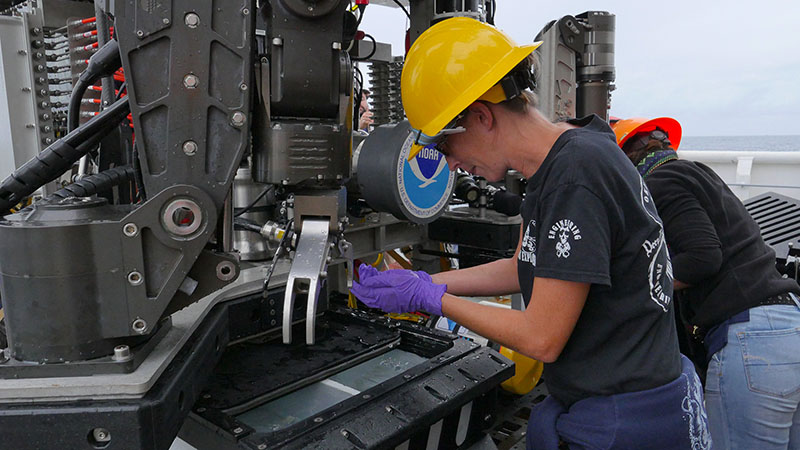
Megan Cromwell. Image courtesy of the NOAA Office of Ocean Exploration and Research, Océano Profundo 2018: Exploring Deep-sea Habitats off Puerto Rico and the U.S. Virgin Islands. Download image (jpg, 1.5 MB).
Megan Cromwell: Two of my favorite sea creatures are crinoids and carnivorous sponges. I am honored to have participated in furthering the scientific understanding of these animals, as we collected specimens of both during this cruise. The carnivorous sponge collection may even establish a new depth record! Sometimes, dreams really do come true!
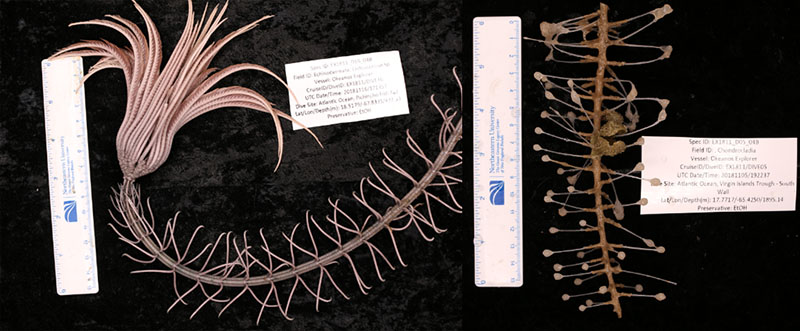
Specimens collected during the expedition included this crinoid and carnivorous sponge. Image courtesy of the NOAA Office of Ocean Exploration and Research, Océano Profundo 2018: Exploring Deep-sea Habitats off Puerto Rico and the U.S. Virgin Islands. Download image (jpg, 427 KB).
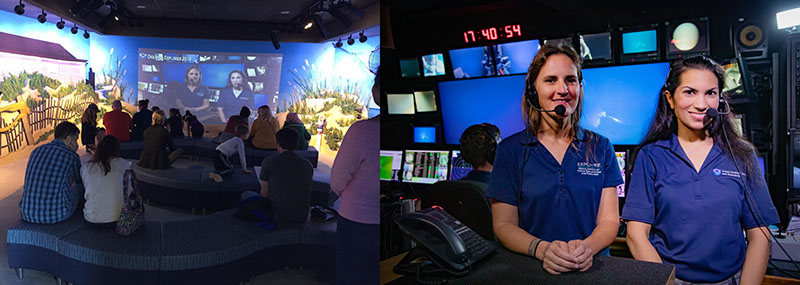
A live interaction with the Charleston Aquarium in South Carolina. Images courtesy of the Charleston Aquarium in South Carolina and the NOAA Office of Ocean Exploration and Research, Océano Profundo 2018: Exploring Deep-sea Habitats off Puerto Rico and the U.S. Virgin Islands. Download image (jpg, 4.3 MB).
Debi Blaney: I enjoyed keeping the world up to date during our expedition by writing for our expedition website and posting on social media, but my favorite experience during this expedition was leading a live interaction from the Okeanos Explorer with the Charleston Aquarium in South Carolina. The Aquarium was hosting a large event for teachers, students, and the general public and were able to “beam” us in live. Everyone asked great questions and I truly enjoyed sharing and communicating the excitement of ocean exploration and our deep-sea discoveries with them. I especially loved questions asked by students, as it is always my hope to encourage and inspire a sense of curiosity about our world in young minds. Not only are young people budding stewards of our planet, they are also our next generation of explorers, scientists, and marine managers; what is considered science fiction today may be their jobs tomorrow: how long before we are engineering ROVs to explore ocean worlds on other planets and moons?
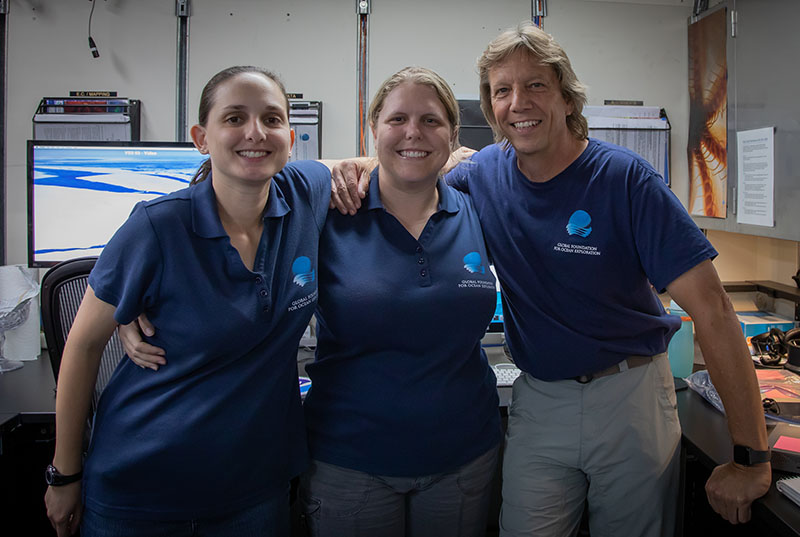
Emily Narrow, Caitlin Bailey, and Art Howard. Image courtesy of the NOAA Office of Ocean Exploration and Research, Océano Profundo 2018: Exploring Deep-sea Habitats off Puerto Rico and the U.S. Virgin Islands. Download image (jpg, 1.5 MB).
Emily Narrow: My favorite moment from the expedition was on the very last day. I went up on the boat deck to watch the crew recover ROVs Seirios and Deep Discoverer from our very last dive. And a swallow flew up and landed not far from my feet. We were about 100 kilometers (62 miles) from the closest land. This poor bird must have gotten blown off course over the open ocean. But it then got lucky, and found our ship, the Okeanos Explorer, and was able to land and rest. It just hung out there at my feet for 20 minutes, while the ROVs were being recovered just below on the fantail. Since I'm on the video team, I take a lot of photographs of life around the ship, so I had my camera with me, and was able to get some photos of this little bird. It was a fortuitous moment.
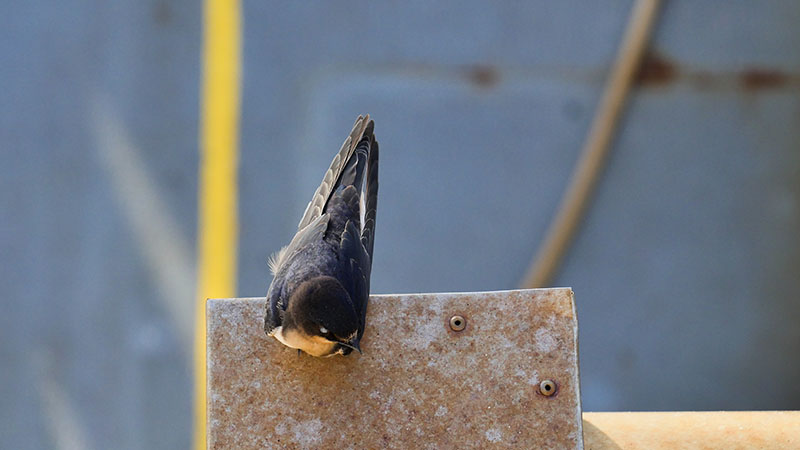
Stray swallow on deck. Image courtesy of Emily Narrow. Download image (jpg, 1.3 MB).
Caitlin Bailey: One of my favorite parts of this expedition was during ROV recovery on November 2. I wanted to take photos of the sunset, which was promising to be a really good one, behind the ship. Just as ROV Seirios was coming out of the water, the sky suddenly turned dark and a squall released its energy in blankets of furious rain. The deck crew and ROV engineers braved the storm and recovered the vehicles safely. It was the most dramatic and best recovery I've ever photographed. You can see the dedication and steadfastness in everyone on deck. I admire each one of these guys and love working with them. Our Okeanos team amazes me on every expedition!
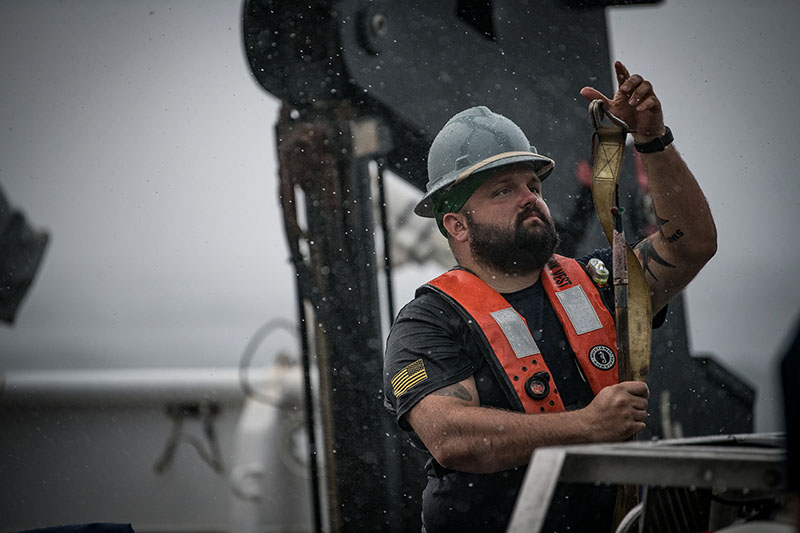
Recovering the ROVs during a rainstorm. Image courtesy of Caitlin Bailey. Download image (jpg, 1.6 MB).
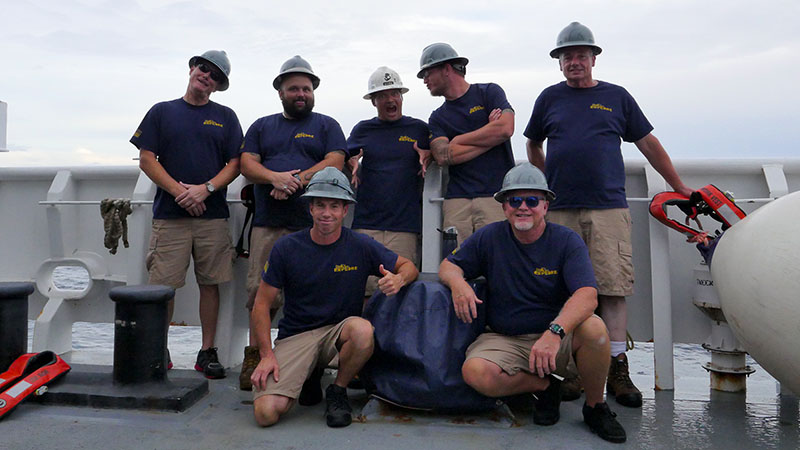
Sid Dunn, Peter Brill, Jerrod Hozendorf, James Scott, Frank Forbell, Eli Pacheco, Mike Collins. Image courtesy of the NOAA Office of Ocean Exploration and Research, Océano Profundo 2018: Exploring Deep-sea Habitats off Puerto Rico and the U.S. Virgin Islands. Download image (jpg, 1.4 MB).
Jerrod Hozendorf: We spend so much time sailing together, we are like family to each other. So our favorite moments of every cruise are always the ones that involve a lot of laughing and goofing around with each other. Maintaining a good sense of humor is important in our line of work, and it’s what keeps me doing this.
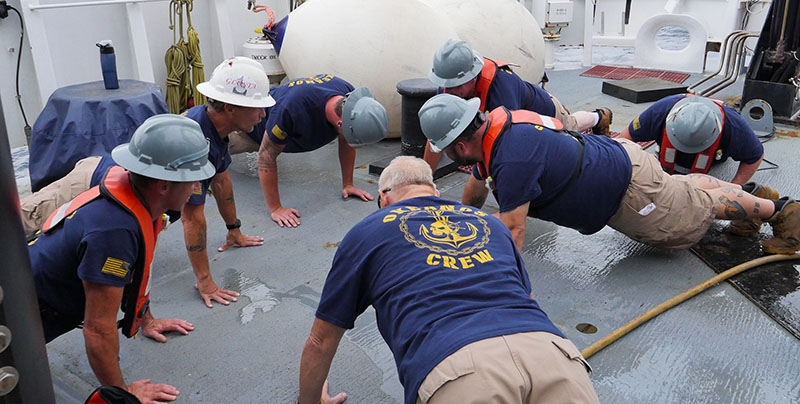
A push-up contest on deck. Image courtesy of the NOAA Office of Ocean Exploration and Research, Océano Profundo 2018: Exploring Deep-sea Habitats off Puerto Rico and the U.S. Virgin Islands. Download image (jpg, 1.5 MB).
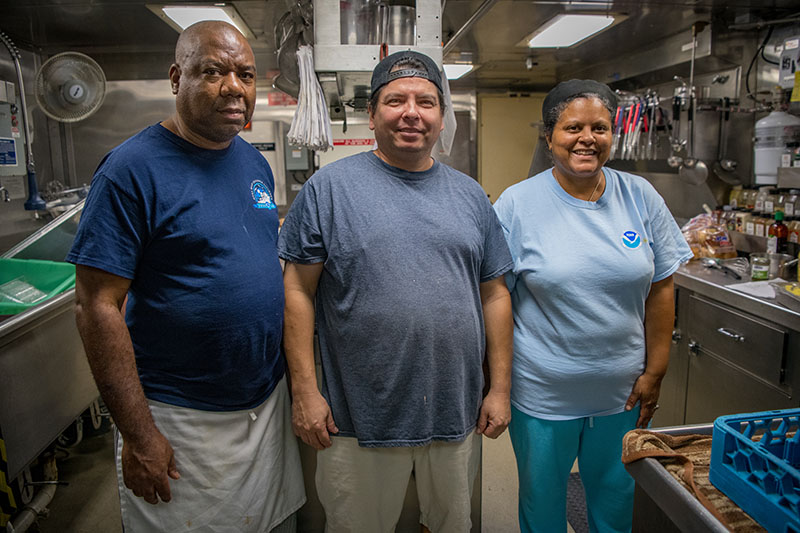
Will Johnson (2nd cook), Mike Sapien (Chief Steward), and Celeste Morris (Acting Chief Cook). Image courtesy of the NOAA Office of Ocean Exploration and Research, Océano Profundo 2018: Exploring Deep-sea Habitats off Puerto Rico and the U.S. Virgin Islands. Download image (jpg, 2 MB).
Will Johnson: My favorite moment of this expedition was when I got to make pizza for the first time in my cooking career.
Celeste Morris: This was my first time on an expedition and my favorite thing about it was meeting all the new people.
Mike Sapien: My favorite moment of the cruise was when the video team filmed a ship tour for kids and came into the galley and interviewed me about my work. I have never done anything like that before. And once the video is done, I can show it to my kids and they can see where I work.
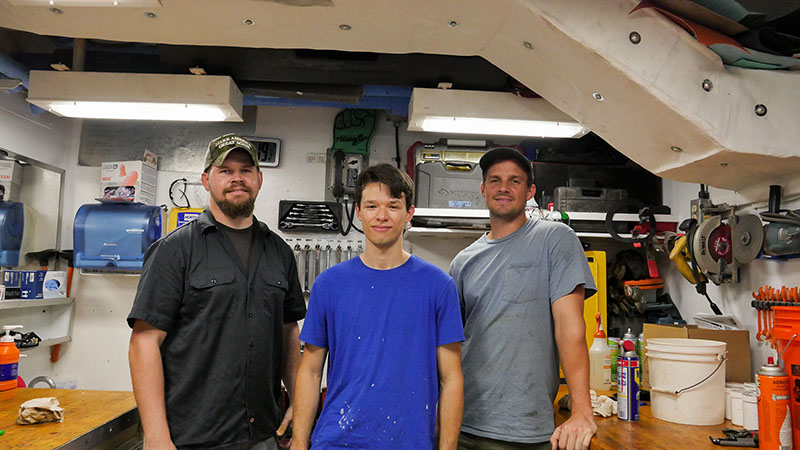
William Rougeux, Christian Lebron, Warren Taylor. Image courtesy of the NOAA Office of Ocean Exploration and Research, Océano Profundo 2018: Exploring Deep-sea Habitats off Puerto Rico and the U.S. Virgin Islands. Download image (jpg, 1.6 MB).
Warren Taylor: By far my favorite thing during the expedition was to go out on the deck and watch the sunrise every morning. The beauty of the ocean and the sun reflecting off of it was a daily treat.
William Rougeux: This was my first time sailing on the Okeanos Explorer, so I really enjoyed meeting all the new people and learning new things every day.
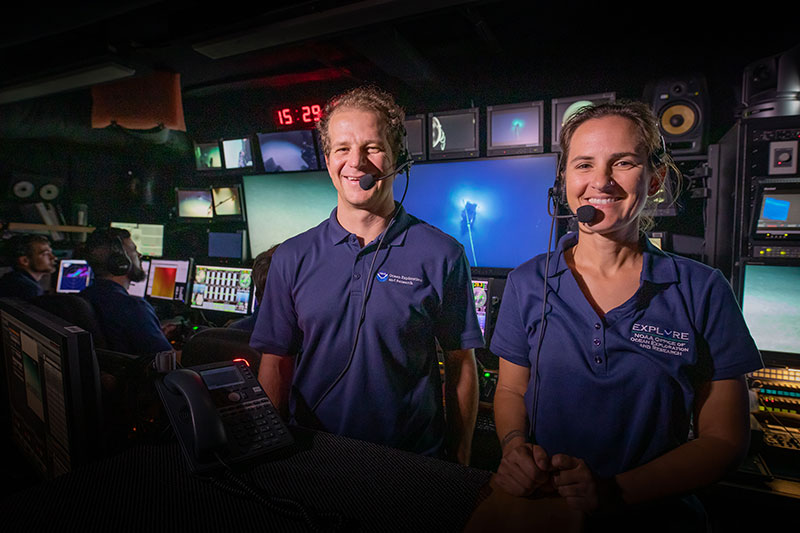
Expedition coordinator Daniel Wagner with science co-lead Stacey Williams. Image courtesy of the NOAA Office of Ocean Exploration and Research, Océano Profundo 2018: Exploring Deep-sea Habitats off Puerto Rico and the U.S. Virgin Islands. Download image (jpg, 928 KB).
There were many highlights during this expedition, as we accomplished some pretty remarkable things, both from a scientific and from an operational point of view. But my favorite moment was when the ship pulled back into port. Quite a few of us were standing outside on deck and looking at San Juan moving closer and closer. As we stood there several of us said, almost in unison, thanks for a great cruise.
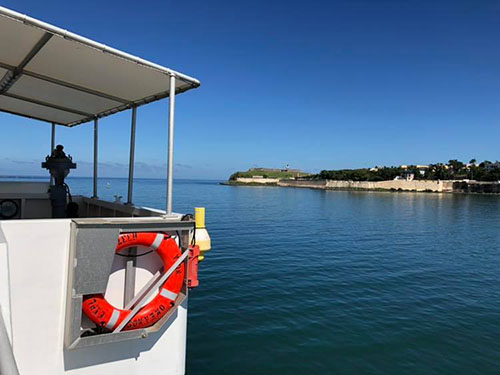
Pulling into port in San Juan. Image courtesy of the NOAA Office of Ocean Exploration and Research, Océano Profundo 2018: Exploring Deep-sea Habitats off Puerto Rico and the U.S. Virgin Islands. Download image (jpg, 137 KB).
As we approach Thanksgiving we are grateful for having safely and successfully completed this important and exciting expedition. We want to extend a warm thank you to everyone who joined us during our dives through our live feed, who followed our discoveries on our website and on social media, and who simply shares our fascination with exploring the unknown and seeing the marvels and beauty of the deep sea. Thank you for tuning in and we hope you join us again on our next expedition.
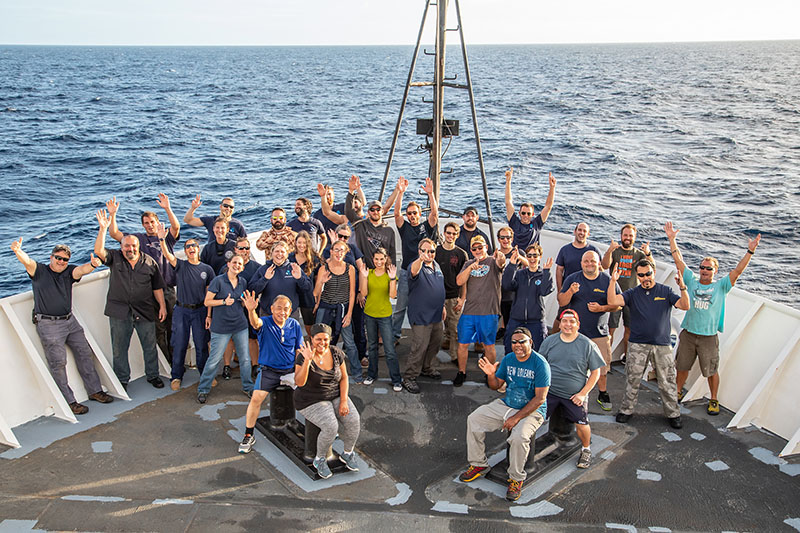
The Océano Profundo 2018 expedition team. Image courtesy of Art Howard. Download image (jpg, 3.6 MB).